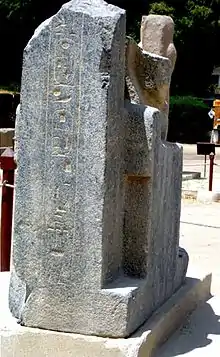Twenty-second Dynasty of Egypt
The Twenty-second Dynasty of Egypt is also known as the Bubastite Dynasty, since the pharaohs originally ruled from the city of Bubastis.[1] It was founded by Shoshenq I.
Twenty-second Dynasty of Egypt | |||||||||||||
|---|---|---|---|---|---|---|---|---|---|---|---|---|---|
| 945 BC–720 BC | |||||||||||||
 Pendant bearing the cartouche of Osorkon II seated King Osorkon flanked by Horus and Isis | |||||||||||||
| Common languages | Egyptian language | ||||||||||||
| Religion | Ancient Egyptian Religion | ||||||||||||
| Government | Absolute monarchy | ||||||||||||
| Historical era | Classical antiquity | ||||||||||||
• Established | 945 BC | ||||||||||||
• Disestablished | 720 BC | ||||||||||||
| |||||||||||||
| Periods and Dynasties of Ancient Egypt |
|---|
|
All years are BC |
|
See also: List of Pharaohs by Period and Dynasty Periodization of Ancient Egypt |
The Twenty-first, Twenty-second, Twenty-third, Twenty-fourth, and Twenty-fifth dynasties of ancient Egypt are often combined under the group designation of the Third Intermediate Period.
Rulers
The pharaohs of the Twenty-second Dynasty were a series of Meshwesh ancient Libyans, who ruled from c. 943 BC until 716 BC. They had settled in Egypt since the Twentieth Dynasty. Manetho states that this Berber dynasty originated at Bubastis, but its rulers almost certainly governed from Tanis, which was their capital and the city where their tombs have been excavated.
Another pharaoh who belongs to this group is Tutkheperre Shoshenq. His period of rule within this dynasty is currently uncertain, although he is now thought to have governed Egypt early in the 9th century BC for a short time between Osorkon I and Takelot I. The next ruler at Tanis after Shoshenq V was Osorkon IV. This pharaoh is sometimes not believed to be a member of the 22nd Dynasty since he only controlled a small portion of Lower Egypt together with Tefnakhte of Sais, whose authority was recognised at Memphis—and Iuput II of Leontopolis.
Pharaohs
The known rulers during the Twenty-second Dynasty include:
| Pharaoh | Throne name | Image | Reign (BC) | Consort(s) | Comments |
|---|---|---|---|---|---|
| Shoshenq I | Hedjkheperre-Setepenre |  | 943–922 BC | Patareshnes Karomama A | Possibly to be identified with the biblical Shishak |
| Osorkon I | Sekhemkheperre-Setepenre |  | 922–887 BC | Maatkare B Tashedkhonsu Shepensopdet A | |
| Shoshenq II | Heqakheperre-Setepenre |  | 887–885 BC | Nesitanebetashru Nesitaudjatakhet | Enjoyed an independent reign of two years at Tanis according to Von Beckerath |
| Takelot I | Hedjkheperre-Setepenre |  | 885–872 BC | Kapes | |
| Osorkon II | Usermaatre-Setepenamun |  | 872–837 BC | Isetemkheb G Karomama B Djedmutesankh | An ally of Israel who fought Shalmaneser III of Assyria at the battle of Qarqar in 853 BC. |
| Shoshenq III | Usermaatre-Setepenre |  | 837–798 BC | Tadibast II Tentamenopet Djedbastiusankh | |
| Shoshenq (IV)"quartus" | Hedjkheperre-Setepenre |  | 798–785 BC | Not to be confused with Shoshenq VI; the original Shoshenq IV in publications before 1993 | |
| Pami | Usermaatre-Setepenamun |  | 785–778 BC | Buried two Apis bulls in his reign | |
| Shoshenq V | Akheperre |  | 778–740 BC | Tadibast III? | Successor of Shoshenq V was often stated as Osorkon IV;some say it is Pedubast II |
| Pedubast II | Sehetepibenre |  | 740–730 BC | Tadibast III? | Not mentioned in all Pharaoh lists, placement disputed |
| Osorkon IV | Usermaatre |  | 730–716 BC | Not always listed as a true member of the XXII Dynasty, but succeeded Shoshenq V at Tanis. Perhaps the biblical Pharaoh So (2 Kings 17:4). | |
Twenty-Third Dynasty
The so-called Twenty-Third Dynasty was an offshoot of this dynasty perhaps based in Upper Egypt, though there is much debate concerning this issue. All of its kings reigned in Middle and Upper Egypt including the Western Desert Oases.
